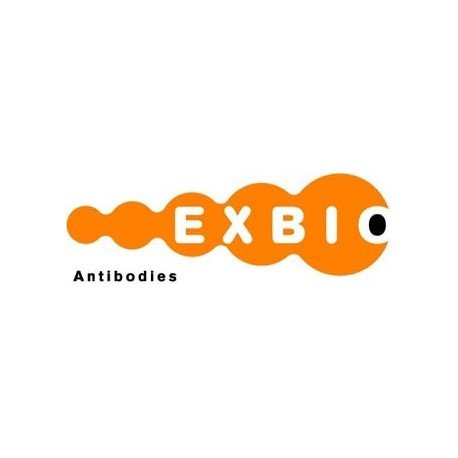Cart 0 Product Products (empty)
No products
To be determined Shipping
0,00 € Total
Prices are tax excluded
Product successfully added to your shopping cart
Quantity
Total
There are 0 items in your cart. There is 1 item in your cart.
Total products (tax excl.)
Total shipping (tax excl.) To be determined
Total (tax excl.)
Data sheet of Mouse Monoclonal to CD200
| Brand | Exbio |
| Product type | Primary antibodies |
| Reactivity | Human |
| Clonality | Monoclonal |
More info about Mouse Monoclonal to CD200
| Brand: | Exbio |
| Product no.: | 1F-746-T025 |
| Product type: | Primary antibodies |
| Host species: | Mouse |
| Product name: | Mouse Monoclonal to CD200 |
| Antigen: | CD200 |
| Clonality: | Monoclonal |
| Clone: | OX-104 |
| Isotype: | IgG1 |
| Immunogen: | Human CD200 |
| Format: | FITC |
| Specificity: | The mouse monoclonal antibody OX-104 recognizes CD200, a type-1 glycoprotein of the immunoglobulin superfamily, which is expressed in neurons, B and T cell subsets, keratinocytes, follicular dendritic cells, and ovarian cells._x000D_ HLDA VII; WS Code 70655 |
| Categories: | Neurobiology (Human), CD and Related Antigens (Human) |
| Storage buffer: | The reagent is provided in stabilizing phosphate buffered saline (PBS) solution containing 15mM sodium azide. |
| Storage / stability: | Store in the dark at 2-8°C. Do not freeze. Avoid prolonged exposure to light. Do not use after expiration date stamped on vial label. |
| Background: | CD200 (also known as OX2 or MRC) is a type-1 membrane glycoprotein, which contains two extracellular immunoglobulin domains, transmembrane domain and cytoplasmic domain. It is expressed by neuronal cells, B and T cell subsets, follicular dendritic cells, keratinocytes, and ovarian cells. The interaction between CD200 and its receptor CD200R results in macrophage activation (IL-6 production), inhibition of mast cell degranulation along with reduced TNF-alpha and IL-13 secretion and overall attenuation of the activation status of lymphocytes. It seems CD200 is also involved in maternal tolerance and its decreased expression in hair follicle correlates with follicular miniaturization. |
| Usage: | The reagent is designed for Flow Cytometry analysis of human blood cells using 4 μl reagent / 100 μl of whole blood or 106 cells in a suspension.The content of a vial (0.1 ml) is sufficient for 25 tests. |
| Preparation: | The purified antibody is conjugated with Fluorescein isothiocyanate (FITC) under optimum conditions. The reagent is free of unconjugated FITC and adjusted for direct use. No reconstitution is necessary. |
| Product specific references: | *Li Y, Zhao LD, Tong LS, Qian SN, Ren Y, Zhang L, Ding X, Chen Y, Wang YX, Zhang W, Zeng XF, Zhang FC, Tang FL, Zhang X, Ba DN, He W, Cao XT, Lipsky PE: Aberrant CD200/CD200R1 expression and function in systemic lupus erythematosus contributes to abnormal T-cell responsiveness and dendritic cell activity. Arthritis Res Ther. 2012 May 23;14(3):R123. doi: 10.1186/ar3853., *Garza LA, Yang CC, Zhao T, Blatt HB, Lee M, He H, Stanton DC, Carrasco L, Spiegel JH, Tobias JW, Cotsarelis G: Bald scalp in men with androgenetic alopecia retains hair follicle stem cells but lacks CD200-rich and CD34-positive hair follicle progenitor cells. J Clin Invest. 2011 Feb;121(2):613-22, *Meuth SG, Simon OJ, Grimm A, Melzer N, Herrmann AM, Spitzer P, Landgraf P, Wiendl H: CNS inflammation and neuronal degeneration is aggravated by impaired CD200-CD200R-mediated macrophage silencing. J Neuroimmunol. 2008 Feb;194(1-2):62-9., *Foster-Cuevas M, Wright GJ, Puklavec MJ, Brown MH, Barclay AN: Human herpesvirus 8 K14 protein mimics CD200 in down-regulating macrophage activation through CD200 receptor. J Virol. 2004 Jul;78(14):7667-76., *Colmont CS, Benketah A, Reed SH, Hawk NV, Telford WG, Ohyama M, Udey MC, Yee CL, Vogel JC, Patel GK: CD200-expressing human basal cell carcinoma cells initiate tumor growth. Proc Natl Acad Sci U S A. 2013 Jan 22;110(4):1434-9., *Shiratori I, Yamaguchi M, Suzukawa M, Yamamoto K, Lanier LL, Saito T, Arase H: Down-regulation of basophil function by human CD200 and human herpesvirus-8 CD200. J Immunol. 2005 Oct 1;175(7):4441-9., *Sopp P, Werling D, Baldwin C: Sopp P, Werling D, Baldwin C: Vet Immunol Immunopathol. 2007 Sep 15;119(1-2):106-14 |
| Related products: | - Mouse Monoclonal to CD206 / MMR - Mouse Monoclonal to CD203c - Mouse Monoclonal to CD205 |
| Shipping condition: | Room temperature |


